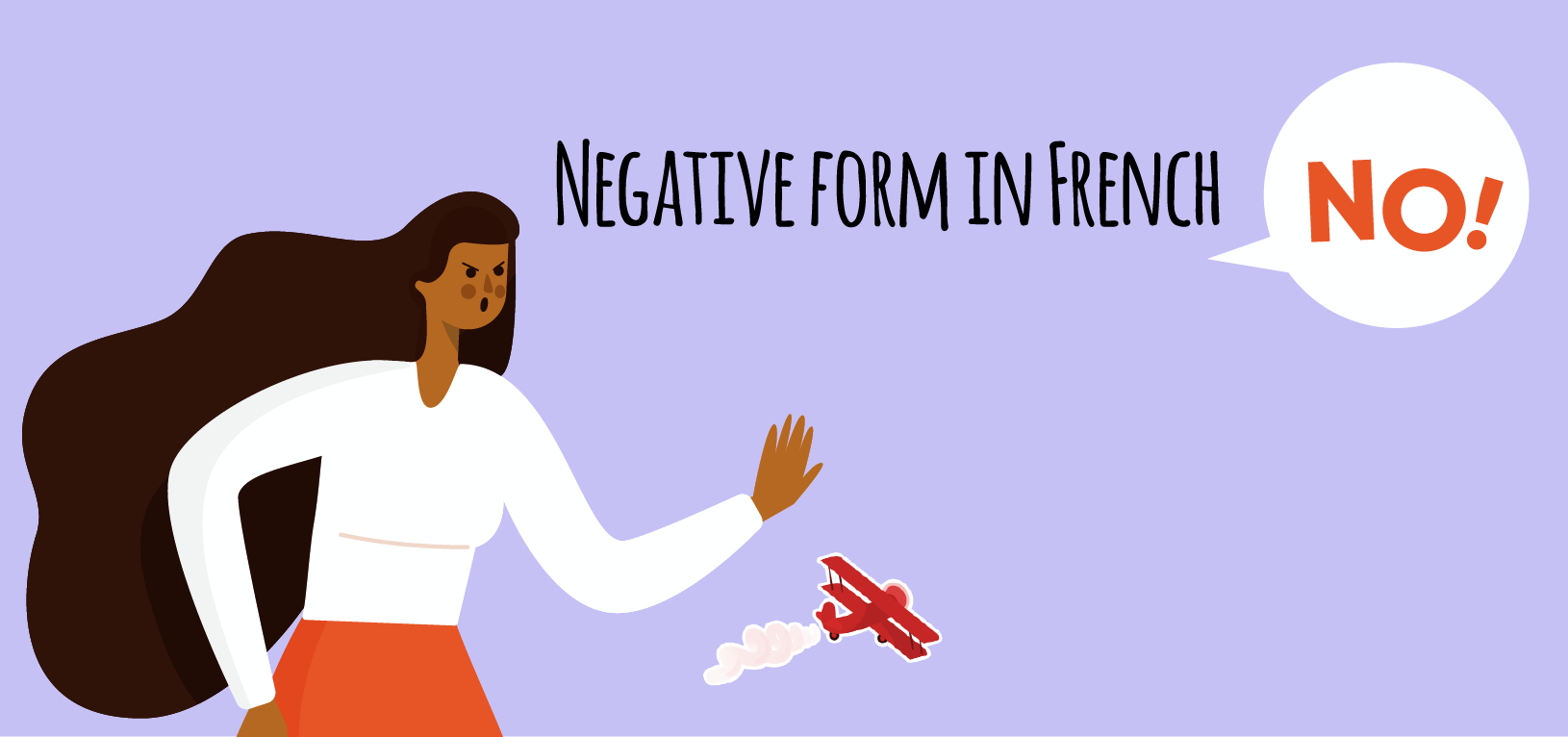Negative form in French

Negative form in French
INDEX OF CONTENTS
- Negative forms in French
- The simplest form
- General form
- Questions
- Never none and nothing
- When not to use ‘ne’
- Negation and pronominal verbs
- Negative infinitive form
The negative form allows you to deny an occurrence within a sentence. Negation in French is quite different from Spanish in that it is (almost) always presented with a compound form. In this article, we will see how negation is formed in French, we will see the different types, their uses and examples for each of them.
French negation can be a bit tricky, but a simple formula and this quick guide will help. These are our tips and tricks to use French negation easily and naturally. The French negation requires two parts. Ne precedes the verb and indicates the negative. A second word (often pas or plus) follows the verb and completes the negation formula.
Negative forms in French
- General form: Pronoun + ne + conjugated verb + pas.
- Negation of pronominal verbs: Pronoun + ne + pronominal form + conjugated verb + pas.
- Negation of compound tenses: Pronoun + ne + avoir / être conjugated + pas + verb in passé composé.
The simplest form
As in Spanish, you can express denial simply by saying “no”. In French it is “non”.
- Voulez-vous un verre ?. Non je préfère le coffee.
Do you want a drink No, I prefer coffee.
- Venez-vous au cinema ?. Non, je dois me lever tôt.
Are you coming to theaters? No, I have to get up early.
- Your m’accompagnes? Non parce que je suis pressé.
Will you accompany me No. because I’m in a hurry.
General form
If the verb begins with a vowel, the particle ne is apostrophized (n ‘). Elle ne travaille pas les dimanches > (She) does not work on Sundays
Example:
- Je ne irrde pas la télé.
(I do not watch tv)
- Je n’aime pas nager.
(I do not like swimming.)
- Je n’aime plus nager.
(I don’t like swimming anymore).
Next, we will show you how to use ne + verb + pas at different times.
Present time
Example:
- Je ne veux happened that your m’accompagnes
I don’t want you to accompany me
- Je ne mange pas de poisson.
(I do not eat fish)
- Je n’aime pas le tabac
I don’t like tobacco
Future time
Example:
- Je n’irai pas à la chasse.
(I will not go hunting).
- You will see me through
(You won’t come with me) .
- Je ne travaillerai pas demain
(I won’t work tomorrow)
The near future
When we construct sentences in the near future, we use ‘aller’ followed by an infinitive verb. To use negation at this time, put ‘ne es pas’ around ‘aller’.
Example:
- Je ne vais pas dessiner demain.
(I will not draw tomorrow).
- Je ne veux pas jouer cet après-midi
(I won’t play this afternoon)
Notice how the negation surrounds the auxiliary verb (aller) and not the infinitive verb.
Compound past tense
Here, we use the same near-future structure. This is because the passé composé (past compound) is formed using être or avoir followed by a past participle. As before, ‘ne es pas’ get along with the auxiliary verb.
Example:
- Vous n’avez pas encore cuisiné.
(You haven’t cooked yet).
Imperative form
The imperative form can be used to give an order.
Example:
- Ne pars pas!
(Do not go!)
With object pronouns
You should use ne + pronoun + verb + pas when there is an object pronoun.
Example:
- Je ne l’achèterai pas.
(I will not buy it).
Questions
The ne… pas The structure can also be used to ask questions in French. The structure is ne + verb + pronoun + pas + verb for questions that use inversion.
Example:
- Did you ever pass?
(Aren’t you dancing?)
- Do you danse-your country?
(Aren’t you dancing?)
- Did you come here?
(You do not want to come?)
- Ne veux-did you come here?
(You do not want to come?)
This may seem a bit complicated, but practice makes perfect!
” Never”, “None” and “Nothing”
By now you have a pretty good understanding of how to create negative sentences in French . If you mean “never”, “nothing” or “nobody”, all you need is wait (nobody), never (never) and laugh (Nothing).
Example:
- Je ne t’oublierai jamais.
(Never forget you.)
- Je ne vois personne.
(I do not see anyone)
- Rien n’est sur la table.
(There is nothing on the table).
When not to use ‘Ne’
In some cases, especially informal situations, it ‘s okay to omit ‘ne’ when you speak.
Example:
- Je ne travaille jamais le dimanche
(I never work on Sundays) It may sound more like, “Je travaille jamais le dimanche.”
Negation and pronominal verbs
The pronominal verbs or reflexive verbs are verbs that have a reflexive pronoun in front of them . For example: Se laver (to wash oneself), S’appeler (to call oneself), Se maquiller (to put on makeup).
In case of negation , the structure that you must respect with a pronominal verb is the following:
ne + reflexive pronoun + verb + pas:
- Je ne m’appelle pas Damien
(My name is not damien)
Examples
- Vous ne vous dépêchez pas !
(Don’t hurry!)
- Il ne se lave pas tous les jours
(He doesn’t wash every day)
- You need to go to 6h normalement
(You don’t get up at 6 normally)
Negative infinitive form
Infinitive verbs can also use the negative form. It is what we will see in many posters on the streets or in parks. This is the structure to be able to do the negation in French with an infinitive verb:
Ne + pas + infinitive
- Ne pas fumer à l’intérieur
(No smoking inside)
- Ne pas jeter des papiers par terre.
(Do not throw papers on the floor.)
- Ne pas entered.
(Do Not Enter.)
- Ne pas stationner.
(No parking.)
- Ne pas déranger .
(Do not bother.)



